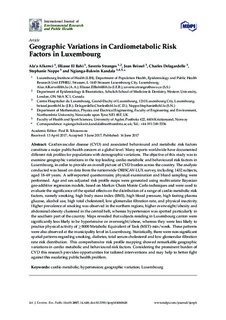| dc.description.abstract | Cardiovascular disease (CVD) and associated behavioural and metabolic risk factors constitute a major public health concern at a global level. Many reports worldwide have documented different risk profiles for populations with demographic variations. The objective of this study was to examine geographic variations in the top leading cardio metabolic and behavioural risk factors in Luxembourg, in order to provide an overall picture of CVD burden across the country. The analysis conducted was based on data from the nationwide ORISCAV-LUX survey, including 1432 subjects, aged 18-69 years. A self-reported questionnaire, physical examination and blood sampling were performed. Age and sex-adjusted risk profile maps were generated using multivariate Bayesian geo-additive regression models, based on Markov Chain Monte Carlo techniques and were used to evaluate the significance of the spatial effects on the distribution of a range of cardio metabolic risk factors, namely smoking, high body mass index (BMI), high blood pressure, high fasting plasma glucose, alcohol use, high total cholesterol, low glomerular filtration rate, and physical inactivity. Higher prevalence of smoking was observed in the northern regions, higher overweight/obesity and abdominal obesity clustered in the central belt, whereas hypertension was spotted particularly in the southern part of the country. Maps revealed that subjects residing in Luxembourg canton were significantly less likely to be hypertensive or overweight/obese, whereas they were less likely to practice physical activity of ≥8000 Metabolic Equivalent of Task (MET)-min/week. These patterns were also observed at the municipality level in Luxembourg. Statistically, there were non-significant spatial patterns regarding smoking, diabetes, total serum cholesterol and low glomerular filtration rate risk distribution. This comprehensive risk profile mapping showed remarkable geographic variations in cardio metabolic and behavioural risk factors. Considering the prominent burden of CVD this research provides opportunities for tailored interventions and may help to better fight against this escalating public health problem. | nb_NO |

